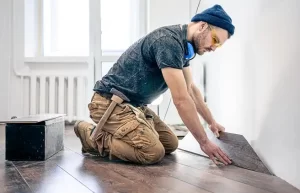Perusing slab yards is always an adventure. At first, it’s novel and exciting. Granite and marble and limestone, oh my! But aisle upon aisle of stone can trigger shopper’s overload. How can you tell them apart? Which one is right for you? Is Brazilian granite superior to Indian granite? And what to make of the enticing labels? Is Verde Butterfly Extra going to make your life better than Verde Butterfly Non-Extra?
Take a deep breath. We have answers for you. While subjective things like shades of off-white (ecru vs. cream?), stone names, and design trends can be dizzying, there is one tool that can reliably help you cut through the confusion. I’m talking about science, my friend.
Aside from the obvious fact that science is super cool and sexy, there’s a real advantage to this approach: you will learn for yourself how stones perform. By experimenting on stone samples, you’ll not only gather key bits of information, but you’ll also gain confidence in the real-world attributes of various stones. There’s nothing like your own personal experiences to reassure you that your stone is going to tick all the boxes for your situation.
Match the properties to the purpose
The first step is to assess your primary needs. A hardworking kitchen countertop in a family home might require durability as the top priority. A bathroom floor might favor texture and grip. A stone patio in Wisconsin needs to resist splitting, while the countertop at a bank will have to resist fingerprints and oils.
If possible, make a list of the properties that are most important to you before you head to the showrooms. That way, you can zero in on the types of stone that fit your criteria, and avoid the potential heartbreak of falling in love with slabs that don’t match your requirements.
Assemble your toolkit
We scientists love our gear, so here’s a list of items you can use to investigate stone samples:
- Glass tile
- Pocket knife
- Small bottle of lemon juice or vinegar
- Spray bottle of water
- Cloth for wiping up water or acid
- Magnifying glass (or use the magnifier function on your phone)
- Camera and notebook to document your findings
Obtaining samples
As you evaluate various types of stone, be sure to explain to the sales staff that you’d like to do a little “sciencing” on some samples. Many dealers are happy to provide samples of stones that you’re considering. This is a smart practice because an educated customer is likely a satisfied customer. Fabrication shops are another source of potential samples, and the scrap bins offer a treasure trove of stones to satisfy your geologic curiosities.
Ideally, industry professionals will appreciate your desire to be as informed as possible, and can accommodate customers who want to ‘test drive’ stones before committing to a purchase. Who knows, perhaps salespeople will be similarly curious about a stone’s performance, and can help guide your investigations. In an age where information is passed along so easily, sometimes without regard for context or validity, it’s in everyone’s best interest to engage in our very own, science-based fact checking.
Hardness
In geology-speak, the hardness of a stone is its resistance to being scratched. Hardness is not the same thing as strength or durability, which we’ll get to in a moment.
Hardness is important when it comes to things like using metal utensils on your countertop, or scuffing muddy shoes across a stone floor. Of all the properties, hardness is the simplest to evaluate. Using a glass tile, check your stone sample to check to see if the stone scratches the glass.
A few tips:
- Use a sharp corner of the stone.
- Press hard, but be careful not to press so hard that you risk breaking the glass. Set the glass on a tabletop to do the test, rather than holding it in your hand.
- There will almost always be a mark on the glass, but it’s not always an actual scratch. Wipe off any stone dust, then feel the scratch with your fingernail. Sometimes the stone simply ‘draws’ on the glass, and sometimes it scratches it. Get a little nerdy and investigate what’s really happening.
Another way to check the hardness of a stone is to use the tip of a knife blade to try to scratch the stone. One advantage of this method is you can examine individual minerals and check out different parts of the stone.
Stones that are harder than glass or a knife blade are likely to stand up well to wear and tear. Softer stones are still perfectly useful, even in high-wear areas, but it depends on your own preferences and needs.
Durability
How well a stone stands up to splitting, crumbling, and cracking are all part of its durability. This is harder to measure because it’s more subtle and subjective. Here are a few categories to investigate.
- Splitting. Many types of stone are layered. Use a broken (not sawn) edge and see if you can peel apart the layers. How strong are the layers? This is especially useful for slate and schist, which have pronounced layering. The large “flashy” areas of layered mica can add stunning beauty to the overall appearance, but can flake off if near the surface.
- Grains. All rocks are made of minerals, but in some cases those minerals are not stuck together too well. Investigate the edges of a stone and see if it’s possible to loosen or remove any grains. Use the tip of a pocketknife and have at it. In most cases, this test is a reassuring one. It’s not easy to pry grains out of a solid rock, and trying to do so will help you recognize the strength of your stone.
- Cracks and fissures. A naturally occurring break in a stone slab is called a fissure, and if it’s human caused (during fabrication or handling, for example), then it’s considered a crack. Fissures in stone are a perfectly normal occurrence. All kinds of geologic stresses can cause a stone to fracture, and in many cases, these areas heal themselves with minerals carried along by groundwater. But once the stone is out of the ground, that process will no longer take place, of course. Weaknesses in the stone are mostly a concern during fabrication, transportation, and installation. Once the stone is in place, it’s not likely to break as long as it’s well supported underneath. That said, it’s wise to investigate any irregularities in a stone’s surface, regardless of if they are natural or not. Can you feel the edge of a fracture on the slab’s surface? If not, then the cracks/fissure is unlikely to be a problem. Does a fracture run all the way through the stone? Will it be near edges or overhangs? If so, then it’s a good idea to trim that area off the slab during fabrication.
Acid resistance
Acids can affect stones that contain calcite or dolomite: marble, dolomitic marble, limestone, travertine, or onyx. Acid sensitivity is another quality that can seem like a mystery, but is easy to measure. Use lemon juice or vinegar, puddle it on the stone, and let it sit for several minutes. Wipe off the acid, then look at the stone at a low angle. Etching looks like a dull area on the surface of the stone. When a stone etches, a tiny amount of the stone dissolves in the acid. This won’t affect the strength or longevity of the stone, but it does make a visual mark. Sealing does not prevent etching, but occasional re-polishing or re-honing will remove etch marks.
Some stones etch quickly and easily. Others take longer to show effects, and etch marks are less noticeable when they do occur. If you love marble but are concerned about etching, you can opt for a honed finish, which often makes etch marks less visible compared to a polished finish. Etching is less of a concern in areas where acids are not used, or for people who don’t aspire to perfection in their homes. So, acid reactions are not necessarily a deal breaker. But a little experimenting will tell you how your potential stone reacts, and will help guide your decision.
An important rule of thumb is that granite, quartzite, and soapstone do not contain acid sensitive minerals. If you want to be sure to avoid etching, then seek these types of stone and do the tests to be sure the stone is classified correctly.
One last clarification on this subject is that we’re talking about everyday acids like citrus, vinegar, wine, or tomato juice. Powerful acids like rust removers and toilet bowl cleaners are much more potent and should be kept away from all types of natural stone.
Staining/porosity
Everybody loves strawberries. But we don’t want to be perpetually reminded of them with a bright pink berry stain on the kitchen island. Staining is linked to porosity—in other words, how much open space exists within the solid matrix of the stone. Thankfully, the high pressures that bind rocks into solid forms tend to squeeze away most of the pore spaces. But different stones have been subjected to different amounts of squeezing, and thus, porosity varies among stone types.
Testing for porosity can be done a few different ways. You can put some water on the surface of an unsealed stone and watch what happens. Does it soak right in? If so, that’s a stone with high porosity. Does the water bead up, and wipe away cleanly? Then you’ve got a tightly compacted, low porosity stone on your hands. If the water doesn’t visibly soak in, but leaves behind a shadow or a damp spot when wiped away, then the stone has intermediate porosity.
If you want to get a little fancier, you can put stone pieces edge-wise in a shallow pan of water and see if water wicks up into the stone. Details about porosity tests are described in the Deep Dive Into the Properties of Quartzite.
You can also check for porosity using cooking oil, but bear in mind that oils will often leave a residue on the surface of the stone even if the oil doesn’t soak into the stone’s pores. After letting oil sit on the stone, scrub it with soapy water, rinse it, and then let it dry completely. At that point you can evaluate the oil’s effect on the stone.
Impregnating sealers should be used with porous stones, and a sealer will reduce or slow the rate of absorption to allow you to clean it before a stain becomes a problem. But that’s your second line of defense. Your best bet is to use the test to find a stone with a lower porosity in the first place, if that’s what your desired usage requires.
Why a basic granite satisfies most measures
There’s a reason why granite is such a popular type of natural stone. It scores well in all the diagnostic tests. It’s made of quartz and feldspar, which are harder than glass. It doesn’t split into layers, and the minerals are held tightly together in an interlocking, jigsaw-like arrangement. None of the minerals in granite are affected by everyday household acids. Granite is also beautiful, and thanks to the wonders of geology, comes in a stunning range of colors and patterns. It’s a win for its properties and its good looks.
It’s often said that knowledge is power—which is certainly applicable when it comes to gathering information and learning about any kind of big purchase. In the case of natural stone, you’ll not only learn about hardness, etching, and porosity, but you’ll also gain insights about geology and the planet. In the end, not only will that help you understand the traits of your natural stone, but it will help you appreciate its origins, too.







